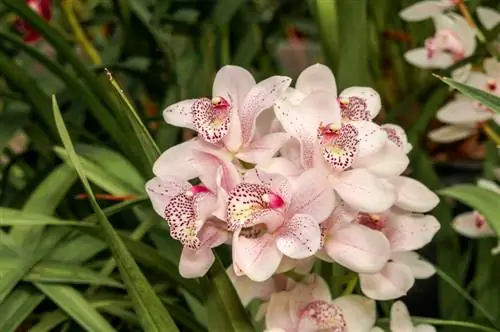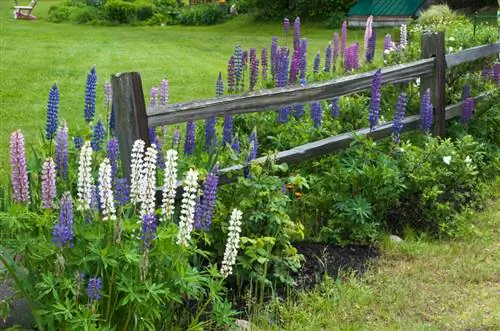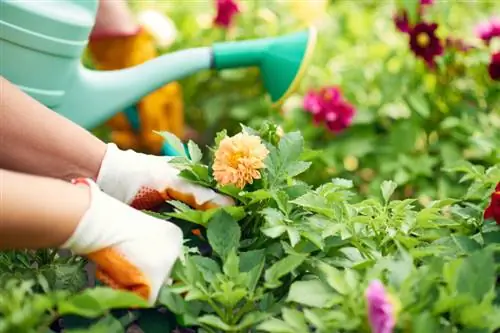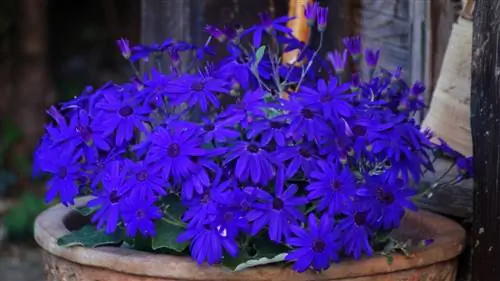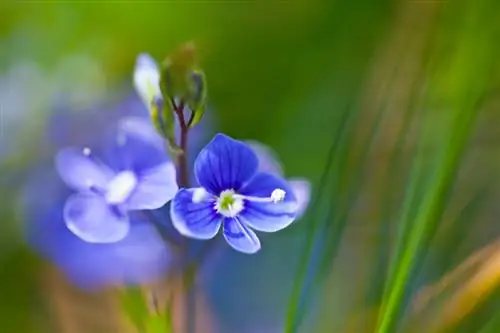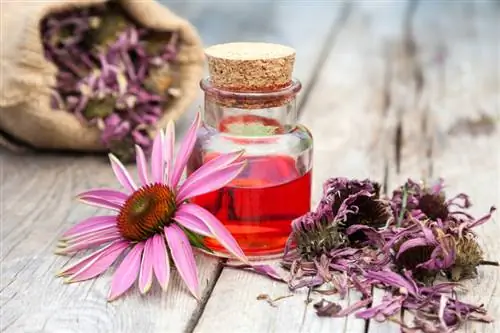- Author admin [email protected].
- Public 2023-12-16 16:46.
- Last modified 2025-01-23 11:21.
Cymbidium orchids, also known colloquially as Kahn orchids because of their characteristic flower shape, grow up to one meter taller than orchid species cultivated indoors. This plant looks magnificent during its flowering period when it opens its large, colorful flowers. Thanks to the sprawling, long leaves, the indoor orchid also looks very attractive outside of its flowering period. However, if you want to cultivate the pretty Cymbidium orchids at home, you need precise knowledge of care and location - the different types are not that easy to keep.
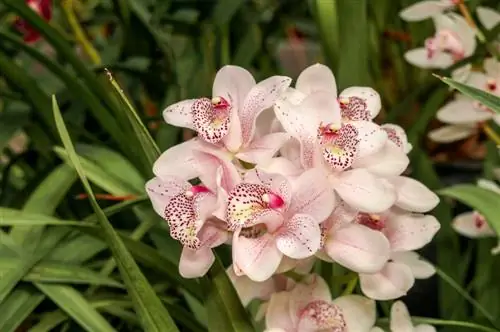
How do I properly care for a Cymbidium orchid?
Cymbidium orchids, also known as Kahn orchids, are demanding houseplants that require bright, indirect sunlight and temperature-dependent care. During growth, they require plenty of water, high humidity and weekly feeding with orchid fertilizer.
Origin and distribution
The word “kymbos”, which comes from the Greek, means something like “barge” or “boat” and refers to the boat-like, arched flower lips of the orchid genus Cymbidium, which has around 70 different species. The German name “Kahnorchidee” for this attractive but not entirely uncomplicated indoor orchid also refers to its characteristically shaped, very large flowers that bloom in numerous colors.
The Cymbidium orchids are native to the forests of Asia, where they are widespread between northern India and Vietnam - some species even grow wild in Australia and Indonesia. Hybrid forms are primarily available commercially, which remain smaller and more compact than the wild species that grow up to one meter high. Cymbidium orchids come in many shapes and colors, but are best cultivated in temperate winter gardens with plenty of space and light. These orchids are not suitable for the windowsill due to their special requirements in terms of temperature and humidity.
Appearance and growth
The wild forms of Cymbidium orchids can grow up to one meter high and quite sprawling. Some of the hybrids available in this country - these are crosses of different species - also reach impressive sizes. Please note that the flower stalks of the plants can still clearly exceed the specified meter size. If you don't have that much space, you can opt for so-called mini cymbidiums, which remain significantly smaller with growth heights of between 15 and 25 centimeters.
Since all Cymbidium orchids are epiphytes, they only develop short rhizomes. The long, strong shoots sprout from these. There are also tuberous thickenings in the lower part of the plants, which are pseudobulbs. These develop from the rhizomes and serve to store water and nutrients. The tuberous, usually egg-shaped to elliptical-shaped bulbs should always be covered with suitable orchid soil.
leaves
The strong green, narrow leaves usually grow overhanging and, depending on the species, can reach a length of up to 100 centimeters. The number of leaves also depends on the specific Cymbidium species: Some of these orchids only develop a few leaves, while others develop many.
Bloom and flowering time
Cymbidium orchids typically bloom between November and February and can produce up to 35 flowers per plant, each up to 13 centimeters in diameter. However, it takes some effort to get the demanding plants to bloom, as they require strong differences between day and night in terms of temperature from summer to autumn. In their homeland it is up to 30 °C during the day, but at night the temperatures drop to around 15 °C.
You would have to recreate these conditions at home in order to be able to enjoy the blooms that last two to three months. This means: In summer and autumn, keep the temperature as warm as possible to up to 30 °C, while at night it should only be around 15 °C. During the winter flowering period, however, you should cultivate Cymbidium orchids in a cool place at 15 to 18 °C. At the same time, the humidity should be kept high at around 60 to 80%.
Cymbidium orchids are available in a wide variety of colors. The flowers on the long flower stalks can be white, yellow, orange, pink, red, violet, brown or even multicolored. For example, varieties with large, speckled flower colors are particularly pretty.
Toxicity
The Kahn orchid is considered non-poisonous. According to current knowledge, there are no known indications of any intolerances.
Which location is suitable?
As typical forest plants protected by a canopy, Cymbidium orchids need a bright but not directly sunny location. In particular, the blazing midday sun should be avoided at all costs, but morning and/or evening sun is good for the plants. However, the right room temperature is much more important: During the day in summer it can get really warm, but during the night cymbidiums need cool temperatures between eight and a maximum of 15 °C. Cool temperatures are also important during the flowering period, so it is best to overwinter these orchids in an unheated or only slightly heated room.
Between May and September, cymbidiums also feel very comfortable in the fresh air, as long as they are protected from direct sunlight and rain in their location in the garden or on the balcony.
In contrast to the large-flowered cymbidiums, the mini forms can also be cultivated on the windowsill, provided you lower the temperature to around ten °C overnight.
Substrate
Cultivate your Cymbidium orchids either in commercially available orchid soil, such as that used for butterfly orchids (Phalaenopsis). Alternatively, you can also use your own mixture of pine or pine bark, sphagnum (don't collect it yourself!) and peat.
Also remember that conventional, pre-fertilized potting soil or potting soil is not suitable for growing orchids. As epiphytes, they have little contact with soil and would be completely overwhelmed with such a substrate. Instead, the optimal orchid substrate should be loose and coarsely crumbly so that the roots are always well ventilated.
Planting and repotting
In contrast to some other types of orchids, the strong-growing cymbidiums require large but narrow planters. New shoots continually grow from the short rhizomes, which is why regular repotting into larger pots and fresh substrate makes sense. You should move a Cymbidium orchid about every two years, because by then its root tubers will certainly have already grown over the edge of the pot. The best time for this is directly after flowering; even newly purchased plants should be given a larger container and fresh substrate as soon as possible.
Also make sure there is good drainage, as cymbidiums are very sensitive to waterlogging. The plant pot absolutely needs a drainage hole at the bottom of the pot from which excess water can drain away. To protect it from siltation (and thus to prevent clogging), cover it with shards of pottery. To improve permeability, the substrate can also be mixed with expanded clay, perlite or similar.
Watering Cymbidium
You also need a sure instinct for watering the demanding Cymbidium orchids. During the vegetation phase, the plant needs a lot of water, but it should not be left permanently wet and should dry out completely between individual waterings. Once the new leaves and bulb-like bulbs have matured, water less. This in turn is important for the formation of flower buds.
Keep cymbidiums as humid as possible, especially in summer and for specimens in the garden or on the balcony, you should use the atomizer every day and spray them all over. However, if the ambient air is too dry, the plants will quickly be attacked by spider mites.
Fertilize Cymbidium properly
Cymbidiums should be supplied with a liquid orchid fertilizer about once a week, which you administer together with the irrigation water.
Cut cymbidium correctly
Cymbidium orchids do not need pruning. Just remove dead flowers and wilted leaves and otherwise just let the plant grow.
Propagate Cymbidium
Cymbidium orchids can be easily propagated by division if they are of the appropriate size. Specimens that have at least six bulbs are suitable for this. Pot them out, carefully remove the remaining substrate and separate the desired sections from each other using your fingers and, if necessary, a large, sharp (and clean!) knife. Each section should have at least one shoot and three older bulbs. Then pot the pieces separately in suitable pots and in fresh substrate.
Diseases and pests
Unfortunately, the beautiful cymbidiums are quite susceptible to pests due to their special care requirements and the associated frequent care errors. Spider mites (the so-called “red spider”), for example, appear when the air in the room is too dry. Leaf suckers such as scale insects, mealybugs, mealybugs and thrips attack damaged houseplants in advance, while ants, millipedes and woodlice often romp around in the plants and, above all, in the substrate when grown outdoors in summer. Snails also like to eat the juicy, green leaves. Only careful care tailored to the needs of the species and regular checks can help against a possible pest infestation.
Tip
Thanks to their long flower stalks and magnificent flowers, Cymbidium orchids are ideal as cut flowers. If you change the water in the vase regularly, the flowers will last for up to three weeks. If possible, do not use cold water from the tap as the orchids are sensitive to limescale.
Species and varieties
Most retailers offer hybrid forms that have been specifically bred to be kept as houseplants. The original species, on the other hand, are primarily cultivated by knowledgeable specialists and are popular collector's items.
- 'Clarisse Carlton': matt pink flowers with white edges and multicolored speckled center
- 'Elmwood': cream-colored flowers with a yellow-red center
- 'Forgotten Fruit': strong flowering variety with pink flowers and darker center
- 'Fort George Lewes': one of the most beautiful green flowering forms
- ‘Ice’: numerous white flowers
- ‘Indian Summer’: Meristem variety with dark flowers and speckled center
- ‘Geyserland’: blooms heavily with dark purple, almost black flowers
- 'Minuet': yellow, brown or green flowers with a spotted center, particularly small in stature
- ‘Mud in the Eye’: Meristem variety with large, dark red flowers
- Peter Pan': yellowish-green flowers with mahogany-red spotted center
- 'Procyon': Meristem variety with light flowers and dark purple center
- ‘Sakura’: cascade shape, numerous pink flowers
- 'The Joker': large, multicolored flowers with white flowers and multicolored center
- 'Waikanae': large, multicolored flowers in various shades of purple and white

